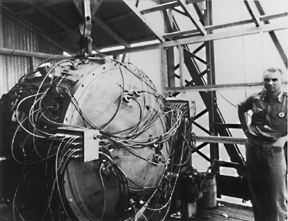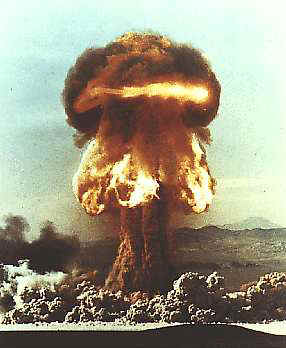Zaman Yolculuğunu Araştırma Merkezi © 2005 Cetin BAL - GSM:+90 05366063183 -Turkey / Denizli
Nuclear weapons
A few words about nuclear weapons technology..
Fission weapons
Nuclear weapons exploit two principle physical, or more specifically nuclear, properties of certain substances: fission and fusion.
Fission is possible in a number of heavy elements, but in weapons it is principally confined to what is termed slow neutron fission in just two particular isotopes: 235U and 239Pu. These are termed fissile, and are the source of energy in atomic weapons. An explosive chain reaction can be started with relatively slight energy input (so-called slow neutrons) in such material.

An actual 239Pu ingot, alloyed with gallium for
improved physical properties
Isotopes are 'varieties' of an element which differ only in their number of neutrons. For example, hydrogen exists as 1H 2H and 3H -- different isotopes of the same chemical element, with no, one, and two neutrons respectively. All the chemical properties, and most of the physical properties, are the same between isotopes. Nuclear properties may differ significantly, however.
The fission, or 'splitting' of an atom, releases a very large amount of energy per unit volume -- but a single atom is very small indeed. The key to an uncontrolled or explosive release of this energy in a mass of fissile material large enough to constitute a weapon is the establishment of a chain reaction with a short time period and high growth rate. This is surprisingly easy to do.
Fission of 235U (uranium) or 239Pu (plutonium) starts in most weapons with an incident source of neutrons. These strike atoms of the fissile material, which (in most cases) fissions, and each atom in so doing releases, on average, somewhat more than 2 neutrons. These then strike other atoms in the mass of material, and so on.
If the mass is too small, or has too large a surface area, too many neutrons escape and a chain reaction is not possible; such a mass is termed subcritical. If the neutrons generated exactly equal the number consumed in subsequent fissions, the mass is said to be critical. If the mass is in excess of this, it is termed supercritical.
Fission (atomic) weapons are simply based on assembling a supercritical mass of fissile material quickly enough to counter disassembly forces.
The majority of the energy release is nearly instantaneous, the mean time from neutron release to fission can be of the order of 10 nanoseconds, and the chain reaction builds exponentially. The result is that greater than 99% of the very considerable energy released in an atomic explosion is generated in the last few (typically 4-5) generations of fission -- less than a tenth of a microsecond.*
This tremendous energy release in a small space over fantastically short periods of time creates some unusual phenomena -- physical conditions that have no equal on earth, no matter how much TNT is stacked up.
Plutonium (239Pu) is the principal fissile material used in today's nuclear weapons. The actual amount of this fissile material required for a nuclear weapon is shockingly small.
Below is a scale model of
the amount of 239Pu required in a weapon with the force that destroyed the
city of Nagasaki in 1945:

In the Fat Man (Nagasaki) weapon design an excess of Pu was provided. Most of the remaining bulk of the weapon was comprised of two concentric shells of high explosives. Each of these was carefully fashioned from two types of explosives with differing burn rates. These, when detonated symmetrically on the outermost layer, caused an implosion or inward-moving explosion.
The two explosive types were shaped to create a roughly spherical convergent shockwave which, when it reached the Pu 'pit' in the center of the device, caused it to collapse.
The Pu pit became denser, underwent a phase change, and became supercritical.
A small neutron source, the initiator, placed in the very center of this Pu pit, provided an initial burst of neutrons -- final generations of which, less than a microsecond later, saw the destruction of an entire city and more than 30,000 people..
Nearly all the design information for weapons such as these is now in the public domain; in fact, considering the fact that fission weapons exploit such a simple and fundamental physical (nuclear) property, it is no surprise that this is so. It is more surprising that so much stayed secret for so long, at least from the general public.
A neutron reflector, often made of beryllium, is placed outside the central pit to reflect neutrons back into the pit. A tamper, often made of depleted uranium or 238U helps control premature disassembly. Modern fission devices use a technique called 'boosting' (referred to in the next section), to control and enhance the yield of the device.
Today's nuclear threat lies mostly in preventing this fissile special nuclear material (often referred to as SNM) from falling into the wrong hands: once there, it is a very short step to construct a working weapon.
What we do now to keep these devices out of the hands of groups like Al-Queda is vital to civilized peoples.

A schematic of a hypothetical 'boosted'
fission weapon
(showing unnecessary 235U)

The gadget device used in the Trinity
test: the world's first nuclear weapon test.
Note spherical geometry and the HE detonator arrangement.
New Mexico, 21KT, 1945.
 |
||
| Typical fission weapon, shortly after detonation at the Nevada test site, with roughly the same yield as the weapon that destroyed Hiroshima. Reddish vapor surrounding the plasma toroid includes intensely radioactive fission fragments and ionized nitrogen oxides from the atmosphere. (Grable, 15KT, 1953) |
Fusion weapons
Fission weapons discussed above are ultimately limited in their destructive capability by the sheer size a subcritical mass can assume -- and be imploded quickly enough by high explosives to form a supercritical assembly. The largest known pure fission weapon tested had a 500 kiloton yield. This is some thirty-eight times the release which destroyed Hiroshima in 1945. Not satisfied that this was powerful enough, designers developed thermonuclear (fusion) weapons.
Fusion exploits the energy released in the fusing of two atoms to form a new element; e.g. deuterium atoms fusing to form helium, 2H + 2H = 4He2 , as occurs on the sun. For atoms to fuse, very high temperatures and pressures are required. Only fusion of the lightest element, hydrogen, has proven practical. And only the heavy isotopes of hydrogen, 2H (deuterium) and 3H (tritium), have a low enough threshold for fusion to have been used in weapons successfully thus far.
The first method tried (boosting) involved simply placing 3H in a void within the center of a fission weapon, where tremendous temperatures and high pressures were attendant to the fission explosion. This worked; contributing energy to the overall explosion, and boosting the efficiency of the Pu fissioning as well (fusion reactions also release neutrons, but with much higher energy).
Because 3H is a gas at room temperature, it can be easily 'bled' into the central cavity from a storage bottle prior to an explosion, and impact the final yield of the device. This is still used today, and allows for what is termed 'dial-a-yield' capability on many stockpiled weapons.
Multistage thermonuclear weapons -- the main component of today's strategic nuclear forces -- are more complex. These employ a 'primary' fission weapon to serve merely as a trigger. As mentioned above, the fission weapon is characterized by a tremendous energy release in a small space over a short period of time. As a result, a very large fraction of the initial energy release is in the form of thermal X-rays.
These X-rays are
channeled to a 'secondary' fusion package. The X-rays travel into a cavity
within a
 cylindrical
radiation container.
cylindrical
radiation container.
The radiation pressure from these X-rays either directly, or through an intermediate material often cited as a polystyrene foam, ablates a cylindrical enclosure containing thermonuclear fuel (shown in blue at left); this can be Li2H (lithium deuteride).
Running along the central axis of this fuel is a rod of fissile material, termed a 'sparkplug'.
The contracting fuel package becomes denser, the sparkplug begins to fission, neutrons from this transmute the Li2H into 3H that can readily fuse with 2H (the fusion reaction 3H + 2H has a very high cross-section, or probability, in typical secondary designs), heat increases greatly, and fusion continues through the fuel mass.
A final 'tertiary' stage can be added to this in the form of an exterior blanket of 238U, wrapping the outer surface of the radiation case or the fuel package. 238U is not fissionable by the slower neutrons which dominate the fission weapon environment, but fusion releases copious high energy neutrons and this can fast fission the ordinary uranium.
This is a cheap (and radiologically very dirty) way to greatly increase yield. The largest weapon ever detonated -- the Soviet Union's 'super bomb', was some 60 MT in yield, and used this technique. Again, to control the yield precisely, 3H may be bled from a separate tank into the core of the primary, as shown in the hypothetical diagram on the left of a modern thermonuclear weapon.
This primary/secondary/tertiary or multistage arrangement can be increased -- unlike the fission weapon -- to provide insane governments with any arbitrarily large yield.
 |
||
| Rare photo of
the actual shrimp device used in Castle Bravo. Note the
cylindrical geometry, and the emergent spherical fission trigger on
the right. Light pipes leading to ceiling are visible near the
fission trigger and at two points along the secondary for
transmitting early diagnostic information to remote collection
points, before they themselves are destroyed.
Note also the incongruous 'danger, no smoking' sign at lower left. 15MT, 1954. |
Fusion, or thermonuclear weapons, are not simple to design nor are they likely targets of construction for would-be terrorists today.
Many aspects of the relevant radiation transport, X-ray opacities, and ultra-high T and D equations-of-state (EOS) for relevant materials are still classified to this day (though increasing dissemination of weapons-adaptable information from the inertially-confined fusion (ICF) area may change this in time). Keeping such information classified makes good sense.

Typical appearance of a
thermonuclear weapon detonation -- from many miles away.
(Castle Romeo, 7MT, 1954)
*Special techniques were required to record the fleeting moments of a weapon's initial detonation. One such method was the Rapatronic camera, developed by Dr. Harold Edgerton. The images it created are bizarre. Check out our collection of Rapatronic photographs.
Hiçbir yazı/ resim izinsiz olarak kullanılamaz!! Telif hakları uyarınca bu bir suçtur..! Tüm hakları Çetin BAL' a aittir. Kaynak gösterilmek şartıyla siteden alıntı yapılabilir.
The Time Machine Project © 2005 Cetin BAL - GSM:+90 05366063183 -Turkiye/Denizli
Ana Sayfa /index /Roket bilimi /![]() E-Mail /CetinBAL/Quantum Teleportation-2
E-Mail /CetinBAL/Quantum Teleportation-2
Time Travel Technology /Ziyaretçi Defteri /UFO Technology/Duyuru